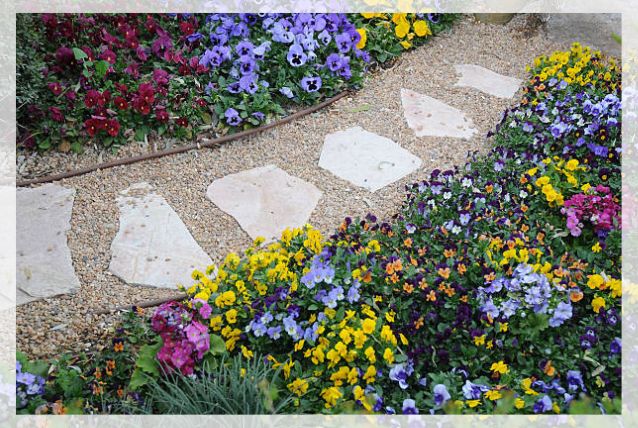Do you know that a Gravel Garden tends to give you an attractive but low-maintenance landscape option?
It is not just reserved for desert-scapes, you can also use gravel to create defined areas in your yard or garden as a base for container gardens.
Moreover, you can choose to provide visual interest with varying sizes and colors of rocks in your yard with this type of garden.
There are a number of options for the fill material for gravel gardens.
These range from small, pea-sized pebbles to larger rocks, including river stones or other landscaping rocks.
In most cases, a gravel garden replaces the top 4 to 8 inches of soil.
You can choose to grow a number of plants though the most popular choices are hardy varieties with minimal watering needs.
Along with a reduction in the watering burden, these gardens are a great choice if you want to reduce weed growth.
How?
Keep on reading.
Gravel Garden
As the name suggests, a gravel garden is an area of land where you can grow native plants in the bordered section of the gravel.
It is a sustainable alternative to some other gardening systems and will need 80% less maintenance than a typical perennial garden.’

When you create a gravel garden, you intend to create a garden that will be good on its own without the input of additional water, fertilizer, and other chemicals you need to protect your plants.
Moreover, the ability of your plants to grow with very little water and zero soil amendments also means you will not need to worry about weed growth.
A lot of weeds that grow in the garden tend to thrive in very rich, moist soils.
However, the dry environment of the gravel garden means that weed seeds will not have what they need to germinate, grow, and thrive in your garden.
Learn more about Weed Management: Why Is It Necessary? here.
Creating a Gravel Garden
It is important to note that anyone can create a gravel garden.
However, they are especially important for you if you have a hard time keeping your plants alive due to harsh growing conditions like dry soil and full sun.
Of course, they are also perfect if you are looking for relatively a hands-off approach to gardening.
If it sounds right for you and your home, you will need to start a gravel garden in the spring.
It is the best time to plant and establish greenery.
Moreover, you can start out small and see how it goes for you if you do not want to jump in full force.
Find the Location: Like a lot of gardening projects, you will need to think about where you want to place your gravel garden.
It can be as simple as a small plot of land in your backyard, or you can make one that takes over your entire landscape.
Moreover, they are great for areas that are already experiencing conditions that make them hot and dry.
An area that receives full sun is ideal for your garden.
It is also important to consider the type of soil you will be working on, soils that are harder to grow in will work well for your garden.
No matter the dirt’s composition, a successful project will always have well-drained soil.
Prepare your Yard: One of the best things about this type of garden is that you can use the existing soil.
However, if the soil is already covered in grass, you will need to start removing it.
You can choose to do it mechanically, or strip it off with a sod cutter.
While other options include covering the turf with black plastic for a year or spraying with herbicides to kill the grass.
After applying the herbicide, mow your grass really short and it will die off.
Create a Border: One of the crucial steps when creating a gravel garden is making a border.
If you do not have something to retain the edge, the gravel tends to taper right off.
It will go from 4 to 5 inches to 3 to 2 to 1 inches to nothing.

Then these edges will be open to weed invasions as they do not have a thick layer of gravel to keep the weed seed from getting a foothold to germinate and grow in the soil.
You can make your border with any common building materials.
These can include rocks, boulders, metal edging, bricks, pavers, poured concrete, and even treated wood.
Moreover, just make sure that the border covers all the edges of your garden.
Lay your Garden: The type of gravel you will be using is the key component to a successful gravel garden.
The gravel should be washed and small, anywhere from 1/4 inch to 3/16 inch would work, according to experts.
A washed gravel simply means that it has been cleaned off of any dirt and debris so that it looks nice when you fill in your landscape.
Pea gravel is round and looks good in a blend of mixed colors.
While sharp gravel is made of granite or quartz and also works well.
After selecting your gravel, you can need to fill in your border.
Spread the gravel out evenly to a depth of about 4 to 5 inches.
You can think of marbles in a jar where you always have airspace between all the marbles, according to experts.
Adding Plants
After laying gravel and preparing it, now is the time you have been waiting for.
You can put your plants into the gravel.
For this, you will need to use drought-tolerant native plants with deep roots.
However, you should not plant seeds in the gravel garden, as it is harder for the roots to establish.
When you plant, you can use 3.5 to 4.5-inch pot-size perennials
This is because they are about the correct depth.

When you use a gallon pot, it will be too big and you will end up shaving off some soil to get them in.
- lay out your potted plants in the area where you want them to grow and keep them about 12 to 18 inches apart
- remove the plant from the pot and hover it over a bushet basket
- over the basket, peel off the top inch of the soil to remove any weed seeds
- dig about 4 to 5 inches deep in the gravel and into the soil and insert the root ball
- fill the area back with soil and gravel
- the gravel should touch the crown of the plant where the stem meets the roots
Plants to Add
Some plants you can add to your gravel garden are:
Euphorbias: These are remarkably drought-tolerant and different species that tend to perform a different role in a gravel garden.
Euphorbia characias subsp. wulfeniia is great for providing shots of lime color, while Euphorbia x pasteurii tends to have sweet blooms.
Nepeta: Catmints are a great, pollinator-friendly addition to your garden.
For quick color, you can have ‘Six Hills Giant; which is hardy and vigorous.
Moreover, Nepeta x faassenii is a great choice for edging plants.
Verbena bonariensis: The airy stems of this plant are great for contrast that they provide with other plants and the bright purple dots of color from the flowers.
Bees and butterflies love its blooms.
Phlomis: Phlomis tend to produce whorls of bee-friendly blooms at regular intervals on their stems.
They are a great architectural addition to your gravel garden as they also provide winter interest in the form of pretty seedheads.
For yellow flowers, you can grow Phlomis fruticosa or Phlomis russeliana and for icy pink blooms you can have Phlomis tuberosa ‘Amazone’.
Cistus: Most cistus are small evergreen shrubs, with compact, domed shapes and saucer-shaped flowers.
Moreover, they combine well with other Mediterranian plants like lavender and rosemary, both of which are at home in a gravel garden.
Stachys: You can have silver, furry-leaved Stachys like ‘Big Ears’ and ‘Silver Carpet’ for a number of reasons in your garden.
They tend to provide a ground cover and flowers for pollinators as well as attract solitary wood carder bees.
These will use wool to line their nests.
Lavender: This plant tends to thrive in dry spots and you can use it for the front of borders.
You can try low-growing varieties like ‘Blue Cushion’ or ‘Nana Alba’, while to fill large gaps you can grow ‘Grasso’ or ‘Sawyers’.

Stipa: These are evergreen grasses that are great for texture and movement they will bring to your planting schemes.
As the name suggests, Stipa gigantea is much larger and you can have them with pompon flowers like alliums, echinops, and eryngium to stand out.
Gaura: These flowers are popular for their drought tolerance and have a lovely relaxed quality about them.
They tend to flower over a long period of time, starting in mid-summer and ending in autumn.
Agave: The key to growing them is to keep them dry over winter.
While in milder locations, most tend to remain outdoors over winter, or you can move them indoors in colder spots.
Moreover, they are worth your effort and provide an unrivaled exotic feel.
Sea Holly: These add architecture with evergreen sword-shaped leaves and thistle-like flowers.
Crambe maritima: Their wavy, slightly wavy leaves tend to have a grey-green tone, while, sprays of white honey-scented flowers appear during the summer.






Leave a Reply